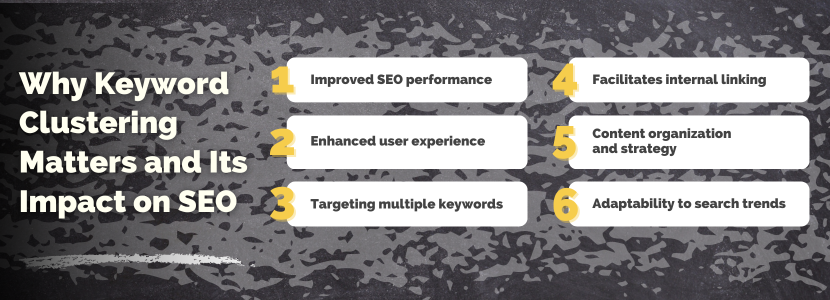Before we delve deeper into the intricacies of SEO strategy, let’s first answer the fundamental question: What is keyword clustering?
Keyword clusters refer to groups of related keywords that share a common theme or topic. Keyword clustering, a fundamental aspect of SEO, involves grouping related keywords to optimize content strategy.
By utilizing keyword clustering tools and a comprehensive keyword research process, you can transform an extensive keyword list into organized clusters that align with the highest search volume and intent.
Terms to know about
Keyword– keywords are fundamental to search engine optimization (SEO) as they are the terms or phrases that users enter into search engines when looking for information.
Interlinking– interlinking refers to the practice of creating hyperlinks within a website that connect one page or piece of content to another.
SEO strategy– SEO (Search Engine Optimization) strategy refers to a comprehensive plan designed to enhance a website’s visibility, ranking, and overall performance in search engine results pages (SERPs).
Pillar content– pillar content, often referred to as cornerstone content or flagship content, is a central and comprehensive piece of content that serves as the main resource for a specific topic or theme on a website.
High-search-volume keywords– high-search-volume keywords refer to specific terms or phrases that are frequently entered into search engines by users.
Search intent– search intent, also known as user intent or query intent, refers to the purpose or goal behind an online search conducted by a user.
Key takeaways
 Keyword clustering is the organization of related keywords around a common theme, a fundamental aspect of SEO that optimizes content strategy.
Keyword clustering is the organization of related keywords around a common theme, a fundamental aspect of SEO that optimizes content strategy.
Keyword clustering matters for improved SEO performance by signaling to search engines the thoroughness and relevance of content.
It is a fundamental part of developing a sound content strategy, guiding the creation of pillar content and subtopic pages for logical and user-centric content structure.
Risks of not clustering include keyword cannibalization, fragmented content, and missed ranking opportunities due to disorganization.
Planning a keyword strategy involves aligning it with business goals, considering a website’s purpose, and understanding the target audience’s needs.
Implementing an SEO keyword cluster includes setting clear objectives, conducting thorough keyword research, creating pillar and cluster content, and monitoring success through tools and metrics.
Why does keyword clustering matter?
Keyword clustering, along with advanced tools like a keyword grouper, stands as a pivotal pillar in the realm of SEO strategies, imparting a profound impact on both search engine algorithms and user experiences.
Let’s delve into the crucial facets that underscore why keyword clustering matters and its multifaceted impact on SEO and content strategy.

Improved SEO performance
Keyword clustering is crucial for SEO success. Search engines, like Google, aim to provide users with the most relevant and comprehensive results. By organizing related keywords into clusters, you signal to search engines that your content is thorough, authoritative, and directly addresses user queries.
Enhanced user experience
Clustering related keywords helps in creating well-organized, cohesive content. Users can find all the information they need on a particular keyword topic in one place, reducing the need to navigate through multiple pages. This improves the overall user experience and encourages longer time spent on your site.
Targeting multiple keywords
With the strategic implementation of keyword clustering and advanced tools like keyword grouper, you can target a variety of related keywords within a single piece of content. This increases your chances of ranking for different search queries, broadening your reach and attracting a diverse audience.
Facilitates internal linking
Organizing content into clusters makes it easier to implement effective internal linking strategies. Internal links between pages within the same cluster help distribute authority and improve the overall SEO performance of your website.
Content organization and strategy
Keyword clustering is a fundamental part of developing a sound content strategy. It guides the creation of pillar content and subtopic pages, making your overall content structure more logical and aligned with user intent.
Adaptability to search trends
As search trends evolve, so can keyword ideas and your content strategy. Keyword clustering allows you to adapt to changing user behaviors and preferences, ensuring your content remains relevant and competitive.
What are the risks of not clustering?
The lack of a clearly defined SEO keyword clustering approach introduces substantial risks to a business’s online content strategy. Let’s explore these risks in detail to understand the critical importance of adopting a strategic approach to keyword clustering.
Keyword cannibalization
Without proper keyword clustering settings, you risk keyword cannibalization, where multiple pages on your site compete for the very same keyword or set of keywords. This can confuse search engines, leading to lower rankings for all pages involved.
Clustering your keywords not only mitigates this risk but also provides a clear strategy for assigning your keywords to specific content pieces, enhancing overall SEO effectiveness.
Missed ranking opportunities
Failing to organize related keywords or leverage tools like keyword grouper means missing out on opportunities to rank for a variety of search queries. Your content may not be as visible or as comprehensive as that of competitors who effectively use an SEO keyword clustering strategy.
How can you plan your keyword strategy?

Crafting an effective keyword strategy is not a one-size-fits-all endeavor; rather, it is a tailored approach that hinges on a deep understanding of your overarching goals. Your keyword strategy serves as the roadmap guiding your online presence, and to chart this course effectively, it is imperative to define your objectives in granular detail.
Aligning keywords with a mission
Begin by aligning your keyword strategy with the broader goals of your business. Ask yourself: Are you looking to enhance brand awareness, drive more sales, or establish authority within your industry? The keywords you choose should be directly connected to these fundamental business objectives.
Tailoring keywords to a website purpose
Consider the primary purpose of your website. Is it an e-commerce platform, a blog, a portfolio, or an informational site? Each of these purposes necessitates a unique emphasis in your keyword strategy.
Understand and connect with your audience
Identify your target audience and delve into their needs and behaviors. What are they searching for, and in what manner? Tailoring your keyword strategy to align with their keyword groups ensures not only relevancy but also engagement.
In essence, the effectiveness of your keyword strategy is intricately tied to a thorough understanding of your business goals, website purpose, and target audience. By meticulously defining these objectives, you lay the groundwork for a nuanced and targeted approach that resonates with your audience and propels your online presence forward.
How to plan your keyword clusters
Creating a robust SEO strategy is a multifaceted process that involves harnessing the power of an SEO keyword cluster and leveraging advanced tools to enhance your website’s visibility on search engines.
Let’s explore each step in detail, incorporating the relevant keywords:
Set clear objectives
Begin by clearly defining your SEO objectives. Whether your goal is to increase search visibility, drive organic traffic, or achieve specific business outcomes, a well-defined objective serves as the North Star guiding your keyword strategy and aligning with relevant keyword groups.
Conduct thorough keyword research
Utilize comprehensive keyword research tools such as Google Keyword Planner, SEMrush, or Ahrefs.
Analyze the total search volume of relevant keywords to generate a comprehensive list that reflects the nuances of user queries within your niche.
Identify primary keywords
Select primary keywords that encapsulate the core themes or topics of your content. These primary keywords act as the foundation, setting the stage for the other keyword groups and the creation of a focused and cohesive SEO keyword cluster.
Discover related keywords
Leverage natural language processing and tools like Google Search Console to uncover related keywords. Look for synonyms, variations, and terms associated with your primary keywords to create a nuanced and expansive keyword list.
Group keywords thematically
Implement a strategic keyword grouper and keyword clustering process, to organize related keywords thematically. Grouping keywords with similar intent creates cohesive clusters, signaling to search engines the comprehensiveness and relevance of your content.
Create pillar content
Develop pillar content around your primary keywords. Utilize insights gained from keyword clustering to create comprehensive and authoritative pages that serve as the core hubs for each thematic cluster.
Craft cluster content
Create supporting or cluster content that delves into specific aspects of each primary keyword. Implement a robust SEO content strategy to address keyword insights and related subtopics in-depth, providing valuable information that caters to varied user interests.
Implement internal linking
Strengthen the structural integrity of your web pages by implementing internal linking between pillar and cluster content. This not only improves navigation but also reinforces the relationships between different pieces of content within the same thematic cluster.
Utilize tools for optimization
Leverage advanced SEO keyword clustering tools such as Surfer SEO or Clearscope to streamline and optimize your keyword clustering efforts. Additionally, use Google Sheets to organize and manage your keyword data and clusters effectively, facilitating a systematic and data-driven approach.
Monitor and adapt
Regularly monitor the performance of your keyword groups and clusters using tools like Google Search Console and other analytics platforms. Adapt your strategy based on search results, user engagement metrics, and changes in search intent, ensuring your approach remains dynamic and responsive.
Optimize for user intent
Align your content with user intent by analyzing search queries and adjusting your SEO keyword cluster accordingly. Pivot your content strategy to meet the evolving needs and expectations of your audience, ensuring that your content remains relevant and valuable.
Find more topics with industry trends
Stay abreast of industry trends and updates in search engine algorithms. Regularly update your keyword clusters to remain relevant and effective in the ever-evolving landscape of SEO, maintaining a proactive stance towards industry changes.
By integrating these steps and keywords, you can develop a comprehensive and tailored keyword strategy that not only maximizes search visibility but also aligns seamlessly with your business goals and the evolving needs of your audience.
How many keywords do I need?
The number of keywords you need for SEO keyword clustering depends on several factors, including the scope of your content, the diversity of your topics, and your overall SEO strategy. Here’s a breakdown of considerations:
Is there any minimum number of keywords required for keyword clusters to be worthwhile?
While there isn’t a strict minimum number of keywords required for SEO keyword clustering, it’s generally more effective with a reasonable number of related keywords.
A good starting point might be to focus on at least five to ten related keywords for each primary keyword or topic. This provides enough variety to create meaningful clusters without being overwhelming.
How many keywords are too many for one cluster?
The ideal number of keywords for one cluster depends on the depth and complexity of the topic. However, it’s advisable not to have too many keywords in a single cluster, as this can dilute the relevance of your content.
Aim for a manageable number, such as five to ten keywords per cluster, to maintain content cohesion and ensure that each keyword contributes meaningfully to the overall theme.
Considerations for choosing keywords
- Search volume: Prioritize keywords with a balance of search volume. Include a mix of high-search-volume keywords to attract a broader audience and low-search-volume, long-tail keywords for specific and targeted content.
- Content relevance: Choose a list of keywords that are directly relevant to the content you are creating. They should align with the primary keyword and contribute to a comprehensive understanding of the topic.
- Search intent: Consider the search intent behind each keyword. Group keywords based on whether users are seeking information, looking to make a purchase, or exploring various aspects of a topic.
- Diversity of topics: Ensure diversity in the topics covered within a cluster. This helps you create well-rounded content that addresses different facets of the overarching theme.
Creating content and ads based on keyword clusters
Applying an SEO keyword cluster to your content and ads can significantly enhance the effectiveness of your SEO and marketing efforts. Here’s how leveraging an SEO keyword cluster can lead to greater success:
Focused content creation
Structuring your content around keyword clusters is akin to creating a roadmap for comprehensive and targeted information delivery. Utilizing natural language processing and related keywords, you can delve into the intricacies of each cluster, offering in-depth insights that cater to diverse user needs.
Increased search visibility
Developing content aligned with an SEO keyword cluster ensures a broader reach across various search queries. Employing keyword insights and grouping related keywords allows your content to capture a spectrum of search intents, thereby enhancing your search engine rankings and visibility in search results.
Optimized SEO performance
Structured content within keyword clusters provides a roadmap for search engines to understand the depth and relevance of your information. Implementing internal linking, incorporating all keywords seamlessly into your content, and organizing them into clusters contribute to improved indexing and ranking, optimizing your overall SEO performance.
Tailored marketing strategies
An SEO keyword cluster acts as a valuable guide for shaping broader marketing strategies. Leveraging related keywords and keyword insights, you can tailor marketing campaigns, SEO initiatives, and content creation to align precisely with the preferences and interests of specific audience segments.
Track SEO keyword clustering success
Tracking the success of your SEO keyword clustering strategy involves a comprehensive analysis of various metrics and indicators. Here’s a detailed breakdown of what to look for and how to discern if your keyword clustering efforts are yielding positive results:

- Google Search Console insights: Regularly monitor the organic traffic to your website using Google Search Console or other analytics tools. Look for consistent increases in organic traffic, especially to pages associated with your keyword clusters. A noticeable uptick in traffic indicates that your content is gaining visibility in search engine results.
- Observing search results: Continuously check the search engine results pages (SERPs) for the keywords you’ve targeted in your clusters. Over time, note any upward movement in rankings for these keywords. An improvement in rankings signifies that search engines are recognizing the relevance and quality of your content.
- Analyzing search intent metrics: Dive into user engagement metrics such as time spent on page, bounce rates, and click-through rates (CTRs) for the pages within your keyword clusters. An increase in time spent on the page, lower bounce rates, and higher CTRs suggest that your content aligns effectively with user intent, leading to improved engagement.
- Reviewing keyword lists and search queries: Examine the diversity of keywords driving traffic to your site. Check the list of keywords and search queries that are bringing visitors. A broad array of keywords driving traffic indicates that your keyword clusters are capturing various search queries effectively.
- Using Google Sheets or internal linking tools: Track the implementation of internal links within your website, specifically focusing on how keyword-clustered content is interconnected. Ensure that your content within clusters is internally linked, creating a structured and cohesive web of information for users and search engines.
- Monitoring individual web pages: Monitor the performance of specific pages within keyword clusters. Identify pages that consistently attract traffic and contribute significantly to the success of their respective clusters, signaling the effectiveness of your content strategy.
Elevate your SEO strategy easily, let Take the Stairs do the heavy lifting!
Crafting an impactful SEO content strategy involves meticulous keyword research, insightful keyword insights, and strategic content planning. However, the intricate process of keyword clustering can be an overwhelming task.
Take the Stairs (TTS) can be your guide for navigating the intricate landscape of SEO keyword clustering. TTS’ SEO and Keyword services streamline the core principles of keyword clustering, transforming what used to be a time-consuming endeavor into a smooth and automated operation.
Contact us now and embark on your journey towards optimized content strategies and increased online visibility!






